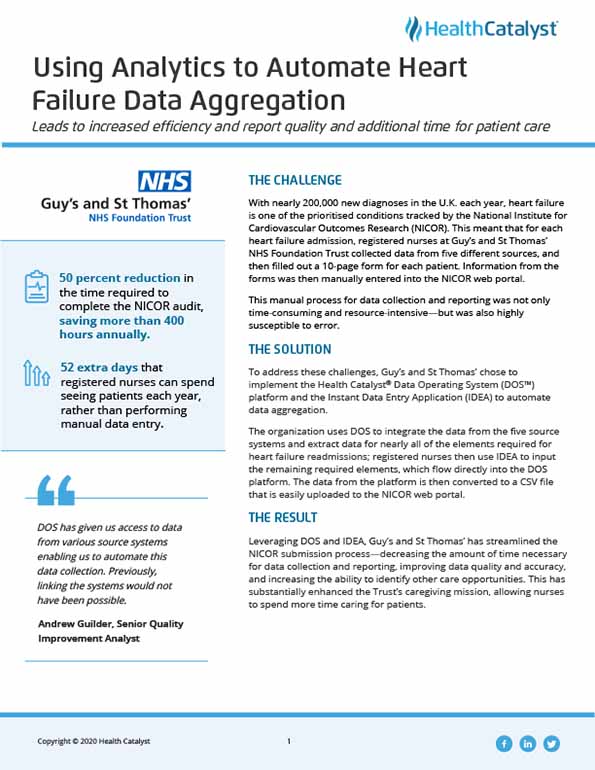Guy's and St Thomas’ NHS Foundation Trust implemented a data platform and analytics application to streamline heart failure data collection. This automated process reduced time spent on reporting, improved data accuracy, and enhanced care quality, allowing nurses to focus more on patient care instead of administrative tasks.
With nearly 200,000 new diagnoses in the U.K. each year, heart failure is one of the prioritised conditions tracked by the National Institute for Cardiovascular Outcomes Research (NICOR). This meant that for each heart failure admission, registered nurses at Guy’s and St Thomas’ NHS Foundation Trust collected data from five different sources, and then filled out a 10-page form for each patient. Information from the forms was then manually entered into the NICOR web portal.
This manual process for data collection and reporting was not only time-consuming and resource-intensive—but was also highly susceptible to error.
To address these challenges, Guy’s and St Thomas’ chose to implement the Health Catalyst® Data Operating System (DOS™) platform and the Instant Data Entry Application (IDEA) to automate data aggregation.
The organization uses DOS to integrate the data from the five source systems and extract data for nearly all of the elements required for heart failure readmissions; registered nurses then use IDEA to input the remaining required elements, which flow directly into the DOS platform. The data from the platform is then converted to a CSV file that is easily uploaded to the NICOR web portal.
Leveraging DOS and IDEA, Guy’s and St Thomas’ has streamlined the NICOR submission process—decreasing the amount of time necessary for data collection and reporting, improving data quality and accuracy, and increasing the ability to identify other care opportunities. This has substantially enhanced the Trust’s caregiving mission, allowing nurses to spend more time caring for patients.
Cardiovascular disease causes one in four premature deaths in England each year and costs the country’s NHS more than £7 billion per year, making it a priority for the NHS.1 There are nearly 200,000 new diagnoses of heart failure in the U.K. each year. Trusts report information on the treatment and management of unscheduled heart failure admissions to NICOR annually.2 The NHS, the government, and regulatory bodies use the data to improve the quality of care.3
The NICOR heart failure audit includes 144 data fields, with approximately one-third of these fields required. For each heart failure admission, registered nurses at Guy’s and St Thomas’ collected data from five different sources, filling out a 10-page form for each patient. The forms were then handed to an administrative team member, who manually input the data into the NICOR web portal.
The clinical data abstraction process was performed manually, making it extremely time-consuming and requiring a full-time resource dedicated to inputting the forms. The manual process also increased the likelihood of error.
Guy’s and St Thomas’ wanted to improve data accuracy and completeness whilst moving away from its burdensome, manual data entry processes. The organisation was also interested in using the heart failure data for improvement. It needed a solution that would reduce the number of resources required to collect and report heart failure data and enable it to use the data for improvement.
To address these challenges, Guy’s and St Thomas’ chose to implement the Health Catalyst® Data Operating System (DOS™) platform and the Instant Data Entry Application (IDEA) to automate data aggregation.
The organisation uses DOS to integrate the data from the five source systems and extract 132 of the 144 data elements required for heart failure readmissions; registered nurses then use IDEA to input the twelve remaining required elements—including a score for breathlessness, peripheral edema, ECG, echo, MRI systolic dysfunction, chest x-ray pulmonary edema, confirmed diagnosis of heart failure, device mode, device therapy, stable on oral therapy prior to discharge, heart failure management plan, and valid NICOR submission—which flow directly into the DOS platform. The data from the platform is then converted to a CSV file that is easily uploaded to the NICOR web portal.
Leveraging DOS and IDEA, Guy’s and St Thomas’ has streamlined the NICOR submission process—whilst improving data quality. The results substantially enhance the Trust’s caregiving mission.
“DOS has given us access to data from various source systems enabling us to automate this data collection. Previously, linking the systems would not have been possible.”
– Andrew Guilder, Senior Quality Improvement Analyst
Guy’s and St Thomas’ will expand its use of the heart failure data and will implement applications and visualisations that will allow the organisation to use the data for improvement.


